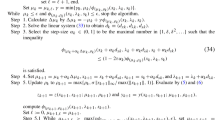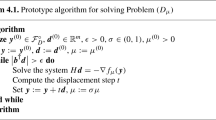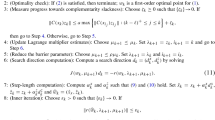Abstract
One motivation for the standard primal-dual direction used in interior-point methods is that it can be obtained by solving a least-squares problem. In this paper, we propose a primal-dual interior-point method derived through a modified least-squares problem. The direction used is equivalent to the Newton direction for a weighted barrier function method with the weights determined by the current primal-dual iterate. We demonstrate that the Newton direction for the usual, unweighted barrier function method can be derived through a weighted modified least-squares problem. The algorithm requires a polynomial number of iterations. It enjoys quadratic convergence if the optimal vertex is nondegenerate.
Similar content being viewed by others
References
Karmarkar, N. K.,A New Polynomial Time Algorithm for Linear Programming, Combinatorica, Vol. 4, pp. 373–395, 1984.
Den Hertog, D., andRoos, D.,A Survey of Search Directions in Interior-Point Methods for Linear Programming, Mathematical Programming, Vol. 52, pp. 481–510, 1991.
McShane, K. A., Superlinearly Convergent\(O(\sqrt n L)\) Iteration Interior-Point Algorithms for Linear Programming and the Monotone Linear Complementarity Problem, SIAM Journal on Optimization, Vol. 4, pp. 247–261, 1994.
Monteiro, R. D. C., andWright, S. J.,A Globally and Superlinearly Convergent Potential Reduction Interior-Point Method for Convex Programming, Technical Report 92-13, Department of Systems and Industrial Engineering, University of Arizona, 1992.
Zhang, Y., andTapia, R. A.,Superlinear and Quadratic Convergence of Primal-Dual Interior-Point Methods for Linear Programming Revisited, Journal of Optimization Theory and Applications, Vol. 73, pp. 229–242, 1992.
Zhang, Y., andTapia, R. A.,A Superlinearly Convergent Polynomial Primal-Dual Interior-Point Algorithm for Linear Programming, SIAM Journal on Optimization, Vol. 3, pp. 118–133, 1993.
Zhang, Y., Tapia, R. A., andDennis, J. E.,On the Superlinear and Quadratic Convergence of Primal-Dual Interior-Point Linear Programming Algorithms, SIAM Journal on Optimization, Vol. 2, pp. 304–324, 1992.
Cheng, Z., andMitchell, J. E.,An Alternative Derivation of the Projective Interior-Point Method for Linear Programming through the Least-Square Approach, Technical Report 208, Department of Mathematical Sciences, Rensselaer Polytechnic Institute, 1993.
Gill, P. E., Murray, W., Saunders, M. A., Tomlin, J. A., andWright, M. H.,On Projected Newton Barrier Methods for Linear Programming and an Equivalence to Karmarkar's Projective Method, Mathematical Programming, Vol. 36, pp. 183–209, 1986.
Fiacco, A. V., andMcCormick, G. P.,Nonlinear Programming: Sequential Unconstrained Minimization Techniques, Wiley, New York, New York, 1968.
Kojima, M., Mizuno, S., andYoshise, A.,A Primal-Dual Interior-Point Method for Linear Programming, Progress in Mathematical Programming, Edited by N. Megiddo, Springer Verlag, Berlin, Germany, pp. 29–47, 1988.
Lustig, I. J., Marsten, R. J., andShanno, D. F.,Computational Experience with a Primal-Dual Interior-Point Method for Linear Programming, Linear Algebra and Its Applications, Vol. 152, pp. 191–222, 1991.
McShane, K. A., Monma, C. L., andShanno, D. F.,An Implementation of a Primal-Dual Interior-Point Method for Linear Programming, ORSA Journal on Computing, Vol. 1, pp. 70–83, 1989.
Mehrotra, S.,On the Implementation of a Primal-Dual Interior-Point Method, SIAM Journal on Optimization, Vol. 2, pp. 575–601, 1992.
Monteiro, R. D. C., andAdler, I.,Interior Path-Following Primal-Dual Algorithms, Part 1: Linear Programming, Mathematical Programming, Vol. 44, pp. 27–41, 1989.
Freund, R. M.,Projective Transformations for Interior-Point Algorithms and a Superlinearly Convergent Algorithm for the w-Center Problem, Mathematical Programming, Vol. 58, pp. 385–414, 1993.
Atkinson, D. S., andVaidya, P. M.,A Scaling Technique for Finding the Weighted Analytic Center of a Polytope, Mathematical Programming, Vol. 57, pp. 163–192, 1992.
Güler, O., andYe, Y.,Convergence Behavior of Interior-Point Algorithms, Mathematical Programming, Vol. 60, pp. 215–228, 1993.
Vanderbei, R. J., Meketon, M. S., andFreedman, B. A.,A Modification of Karmarkar's Linear Programming Algorithm, Algorithmica, Vol. 1, pp. 395–407, 1986.
El-Bakry, A. S., Tapia, R. A., andZhang, Y.,A Study of Indicators for Identifying Zero Variables in Interior-Point Methods, SIAM Review, Vol. 36, pp. 45–72, 1994.
Ye, Y., andKojima, M.,Recovering Optimal Dual Solutions in Karmarkar's Polynomial Algorithm for Linear Programming, Mathematical Programming, Vol. 39, pp. 305–317, 1987.
Author information
Authors and Affiliations
Additional information
Communicated by R. A. Tapia
The research of the second author was supported in part by ONR Grants N00014-90-J-1714 and N00014-94-1-0391.
Rights and permissions
About this article
Cite this article
Cheng, Z.Y., Mitchell, J.E. A primal-dual interior-point method for linear programming based on a weighted barrier function. J Optim Theory Appl 87, 301–321 (1995). https://doi.org/10.1007/BF02192566
Issue Date:
DOI: https://doi.org/10.1007/BF02192566




